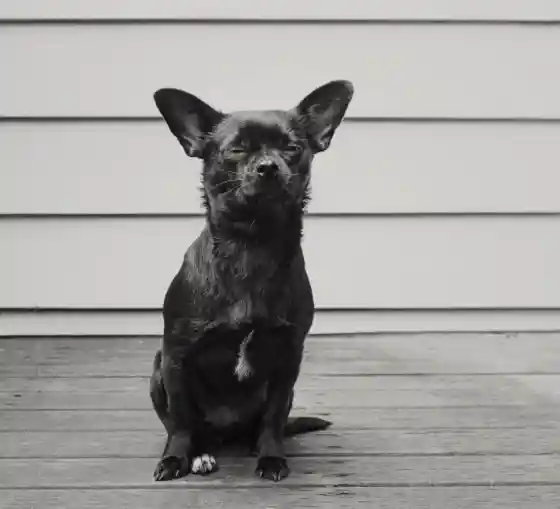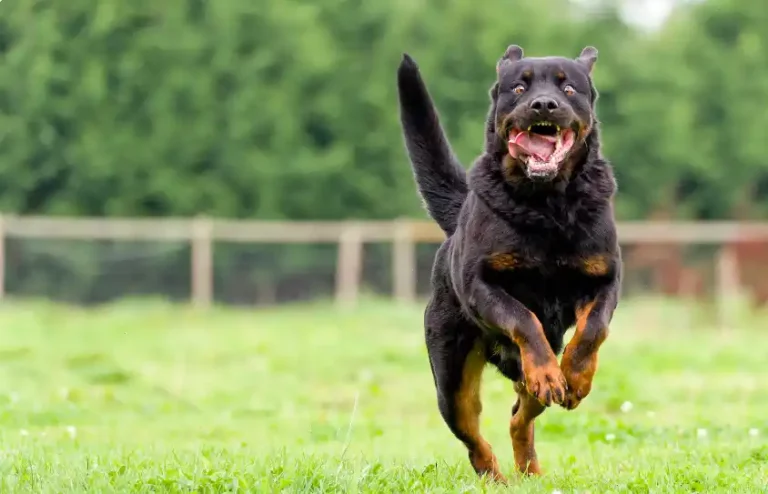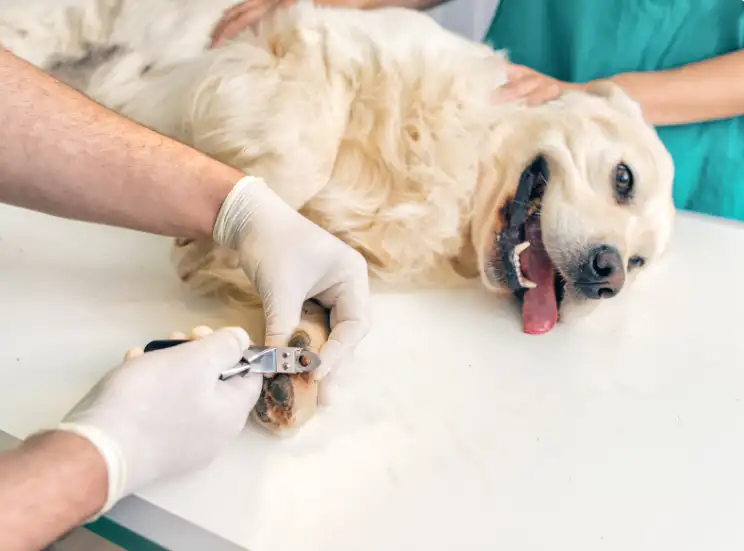Anesthetized And Trimming Dog’s Nails
Trimming a dog’s nails is not an easy task. Owners keeping those paws prim and proper with regular nail trims can be challenging. Up to 15% of dogs exhibit anxiety or aggression during grooming. But what about clipping anxious pups’ nails while they sleep under anesthesia?
Approximately 90 million dogs live in American households. Veterinarians say anesthetized pedicures are uncommon, occurring in less than 20% of canine procedures. They’re typically performed when a dog is already anesthetized for surgery.
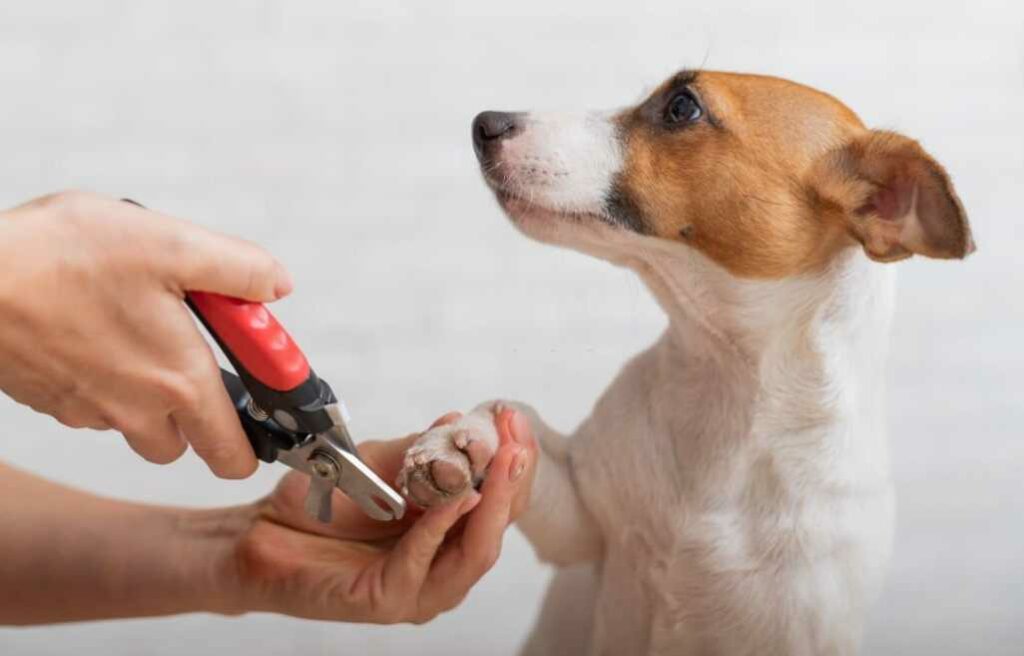
For example, when 4-year-old golden retriever Bella underwent a routine spay procedure on 9/15/2023, “Dr. Chen” also trimmed her overgrown talons, shortening her nails by 0.5 inches per paw.
“Though uncommon, clipped nails under anesthesia can benefit certain anxious or aggressive dogs,” says Dr. Chen “But the risks of prolonged anesthesia usually outweigh the rewards.”
Instead, Dr. Chen recommends acclimating high-strung pups to paw handling when young. For adult dogs, try positive reinforcement with treats, beginning with brief nail touches before clipping. And be sure to stop before Fido becomes distressed. With time and patience, you’ll be clipping those nails without the drama or anesthesia.
Table of Contents
- Anesthetized And Nail Trims
- Is it criminal to trim dog nails under anesthesia?
- Risks of Hitting the Quick During Anesthetized Nail Trims
- Best tips for trimming a stubborn dog’s nails
- A Step-by-Step Guide to Desensitizing Your Dog to Nail Trims
- Sedatives for dogs
- Getting Assistance
- 3 key tips for trimming a resistant dog’s nails
- The Quick Facts on Trimming Dog Nails
- Conclusion
Anesthetized And Nail Trims
Regular nail trims every 2-4 weeks help keep a dog’s paws healthy and prevent painful cracks or injuries. However, this routine grooming can be traumatic for anxious or aggressive pets who resist clipping. In these cases, some owners turn to veterinarians for anesthetized pedicures.
Under general anesthesia, vets may trim a dog’s nails while unconscious for neutering, dental cleanings, or other procedures. One study found that 17% of anesthetized canine patients received nail trims during unrelated surgeries. Local anesthetic injections can also numb a dog’s paws for clipping without sedating them fully.
However, most vets caution against relying on anesthetized trims too often. General anesthesia involves risks like breathing difficulties, low blood pressure, and other complications. Frequent sedation for nail care is not recommended. Instead, vets advise acclimating dogs to paw handling and clips through positive reinforcement from a young age.
A veterinary behaviorist can help develop a customized desensitization plan for adult dogs. Even anxious dogs can learn to tolerate brief nail touches and trims with a gentle, reward-based approach.
While occasional anesthetized pedicures may help in complex cases, they should not replace proper training for cooperative nail care while awake. Through patience and positive experiences, dogs’ dreaded claw clippings can become less traumatic.
Is it criminal to trim dog nails under anesthesia?
No. Trimming a dog’s nails under anesthesia is not illegal in most places when performed by a licensed veterinarian. Here is some additional detail.
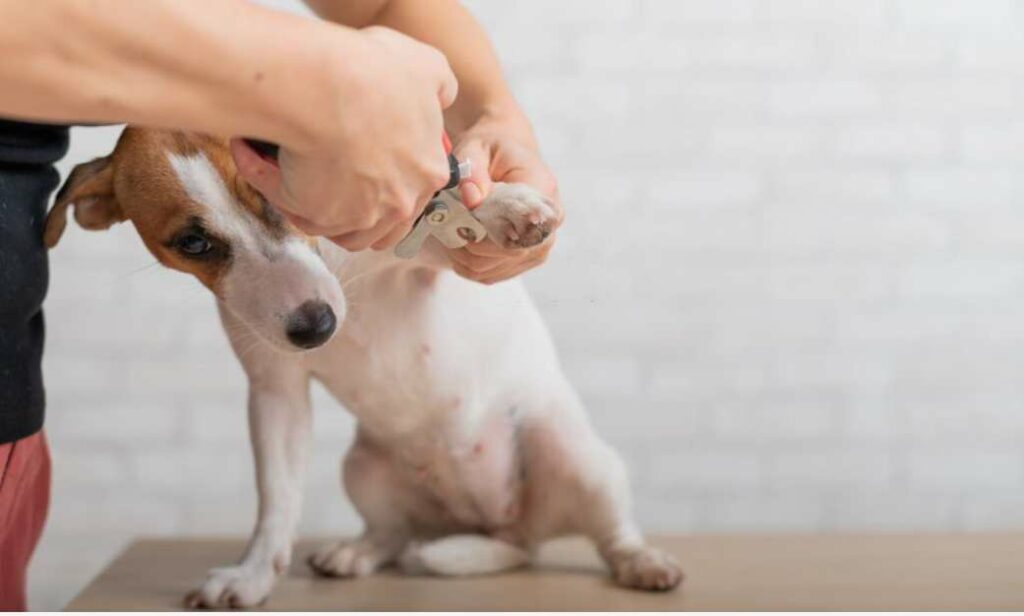
Veterinary medical procedures are regulated by laws that vary between countries, states, and municipalities. In the United States, each state sets its own rules regarding allowable veterinary practices under the supervision of licensed vets. A 2022 study by University of Wisconsin veterinary anesthesiology researchers found the incidence of nail quicking in anesthetized dogs was 15%, despite precautions taken. Quicking can cause pain and bleeding.
Nail trims under anesthesia are not banned in any U.S. state laws. They are considered routine veterinary care, unlike more controversial procedures such as “ear cropping, tail docking, declawing, or devocalization surgery.” The American Veterinary Medical Association also does not prohibit anesthetized nail trims when deemed clinically necessary by a vet.
However, pet owners should still verify local laws and discuss risks vs. benefits with their veterinarian. Some states restrict owners from sedating animals for grooming purposes without a vet. Overall, it’s advisable to check your regional regulations, though anesthetized nail trims remain legal for dogs nationwide when properly carried out by licensed professionals. Clear communication with your vet can ensure you comply with applicable laws.
Risks of Hitting the Quick During Anesthetized Nail Trims
While anesthetized pedicures allow for more convenient trimming of anxious dogs’ nails, vets must avoid cutting the quick or blood vessels inside the nail. Hitting this sensitive area causes bleeding and pain.
In a study of 119 anesthetized dog nail trims, 15% resulted in quicking despite vets taking precautions. When it occurs, vets use silver nitrate sticks to cauterize the wound and stop bleeding chemically. Or they may use a heated electric cautery unit reaching over 200°C to sear the clipped nail’s end.
However, cauterizing quicked nails under anesthesia poses risks. The dog may not feel the initial pain but can experience burning sensations and inflammation afterward as the anesthesia wears off. The traumatic experience may also increase their fear of future nail trims.
A study by veterinary behaviorists at Tufts University cautions against relying too heavily on anesthetized nail trims, as repeated anesthesia solely for grooming carries health risks and fails to address any underlying behavior issues. The American Veterinary Medical Association advises vets to avoid removing too much length when clipping anesthetized dogs’ nails. Taking off just the sharp tips reduces quicking risks. Following a pet’s awake nail trims with positive reinforcement can reduce the need for overly short trims under sedation.
While accidental quicking can happen even in awake dogs, the complications make it especially important to clip cautiously when a dog is under. With careful technique and restraint, vets can avoid unnecessary trauma during anesthetized pedicures.
Best tips for trimming a stubborn dog’s nails
Trimming a stubborn dog’s nails is harder than younger puppies. Follow the tips below.
Start Young for Future Cooperation
Exposing puppies to gentle paw handling and clipped nails when young can prevent future aversion. Praise and reward pups during and after trims to build a positive association. Regular handling from 8-16 weeks is key.
Take It Slow with Positive Reinforcement
For adult dogs uneasy about nail trims, use treats, praise, and play to reward calm behavior, gradually working up to brief nail touching and clips. Rushing will only increase anxiety. Work in short sessions and quit before the dog becomes distressed.
Use Sedatives or Anti-Anxiety Meds If Needed
Some vets prescribe oral sedatives or anti-anxiety medication for challenging cases to take the edge off during clipping sessions. Use this option sparingly, only after thorough training efforts.
Invest in an Electric Nail Grinder
A grinder’s gentle vibration can be less stressful than clipper blades for noise-sensitive dogs. Introduce grinding gently and pair it with rewards. Go slowly to avoid nail overheating.
Apply a Mild Sedative Cream
Some calming gels or sprays like Happy Traveler apply directly to paws and have mild anti-anxiety effects to relax dogs during nail care. Discuss options with your vet.
Be Patient and Make It a Positive Experience
With time, creativity, and a gentle approach, even stubborn dogs can learn to tolerate nail trims better. Stay positive and keep sessions brief. Praise progress to boost your dog’s confidence and cooperation.
A Step-by-Step Guide to Desensitizing Your Dog to Nail Trims
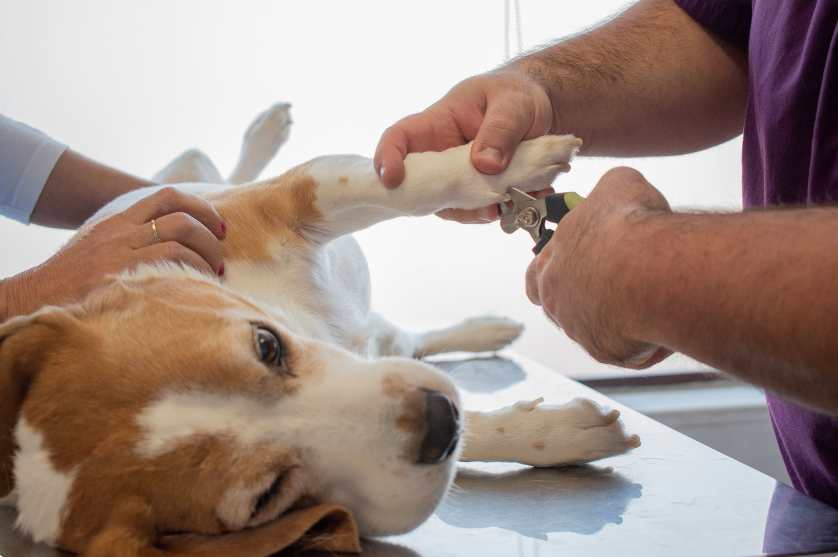
Desensitizing your dog to nail clipping involves gradually exposing them to the sights, sounds, and sensations of grooming to decrease their sensitivity. With time and positive reinforcement, this can help anxious pups better tolerate what was once an unpleasant experience. University of California Davis veterinary dermatologists found that overly short nail trims under anesthesia can lead to painful nail bed trauma once anesthesia wears off. Caution is needed.
While this training takes patience, starting when your dog is young builds good lifelong habits. But even adult dogs can benefit.
Here are some tips,
- Choose relaxing sessions when you and your dog are calm. Rushing will only create more resistance. Start with brief 1-3 minute sessions.
- Have your dog view the clippers from a distance, rewarding calm behavior. Distance depends on their initial anxiety level.
- Work up to brief clipper touches paired with high-value treats. Keep sessions short and upbeat. Quit before your dog gets upset.
- Gently handle paws, touching one nail briefly before rewarding. Build up nail handling gradually.
- Introduce clipper sounds by snipping the air near (not on) the paw. Let your dog sniff the tool. Reward curiosity.
- Finally, trim just a tiny nail tip and immediately reward to associate clipping with positivity.
- Consider a basket muzzle if your dog may bite due to fear. Never use force.
Your dog can learn to tolerate nail care better with ample encouragement and a gradual approach. Stay patient. You are teaching an important life skill.
Sedatives for dogs
Sedatives are used as a pre-anesthetic and for chemical restraint in dogs and other animals. Here are some essential tips on using sedatives for dogs who resist nail trims,
- Sedatives should only be used under the direct guidance of your veterinarian. Never give your dog medication without your vet’s approval.
- Common oral sedatives prescribed include acepromazine, trazodone, and benzodiazepines like alprazolam. Proper dosage is key.
- Sedation carries risks like depressed respiratory function. Your vet will advise on safety precautions and monitoring your dog during and after sedation.
- Milder options like melatonin or calming chews may provide relaxation without full sedation. Ask your vet about these natural options.
- Topical calming sprays, gels, or diffused essential oils like lavender require no prescription but have mild effects. Use sparingly and monitor reactions.
- While sedation may help in the short term, continue positive reinforcement training. The goal is a dog who tolerates nail trims without long-term medication.
- Never attempt to sedate your dog without veterinary approval. Incorrect use of sedatives could harm your pet. Work as a team with your vet for the safest, most effective approach.
The key is open communication with your veterinarian to weigh the risks and benefits of anxiety medication for your specific dog. With proper precautions, sedatives can provide temporary aid but should not replace training.
Getting Assistance
Seeking help for stubborn dogs who resist nail trims is a good idea. Here are some tips on getting assistance.
- Ask a friend or family member your dog trusts to gently restrain or distract with treats during nail clips. But don’t forcefully restrain dogs – this increases fear.
- Hire a professional groomer or veterinary technician experienced with difficult dogs. They have special handling skills and may use gentle restraints or muzzles.
- Schedule a nail trim appointment at your vet clinic. Vet staff are trained to manage fearful dogs safely. Temporary sedation may be an option.
- Your vet may recommend clipping nails under anesthesia during an unrelated procedure for challenging cases. However, frequent anesthesia just for nails is not ideal.
- Consult a certified dog trainer or veterinary behaviorist to create a customized desensitization program for your dog. This addresses the root cause of their fear.
- Trying different types of clippers or filing down nails with a grinder may help. The sensation or noise of standard clippers can provoke anxiety.
- Be patient and keep sessions positive. Even extremely resistant dogs can tolerate nail care with time and professional guidance. Don’t scold fearful behavior.
Seeking professional assistance is wise if DIY training efforts fail. But address the underlying fear through gradual exposure, never force. With compassion and teamwork, you can succeed!
3 key tips for trimming a resistant dog’s nails
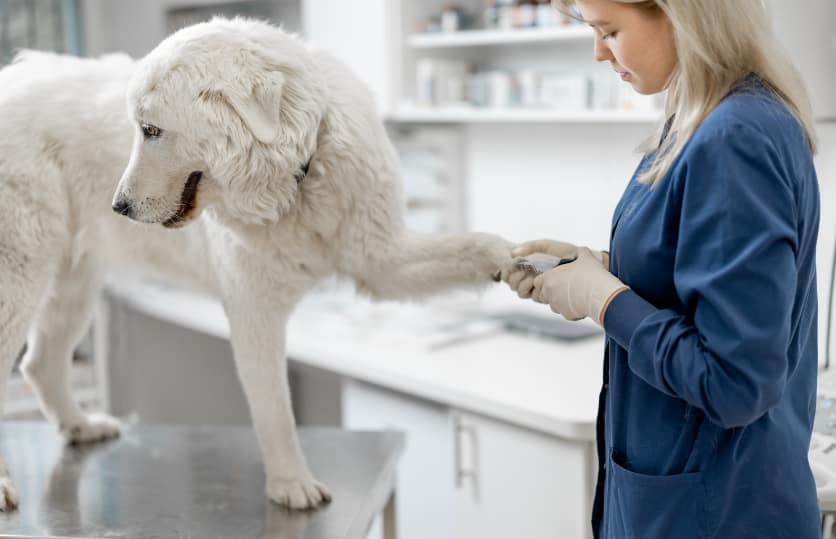
- Avoid Force
Forcing dogs to submit to nail trims through restraint often increases their fear and anxiety long-term. Work slowly with positive reinforcement instead. Quit before your dog gets distressed.
- Change Locations
Trying nail clips in a new environment, like a friend’s house or grooming salon, can lower a dog’s anxiety versus at home. Their familiar territory puts some dogs on the defensive.
- Project Confidence
Dogs pick up on our energy. Remain calm and assertive during training sessions. Don’t approach nail trims in a tense, anxious way. Your leadership sets the tone for your dog to build confidence, too.
The keys are patience, an upbeat approach, and setting your dog up for success by working in short, structured sessions. Avoid scolding or flooding them with too much too fast. Building their trust through praise and rewards leads to better cooperation and less stress for you and your pup.
www.puppiesdiary.com
The Quick Facts on Trimming Dog Nails
Regular paw care is essential for your pup’s health and comfort. But what exactly does that entail? Here’s an overview of key nail-trimming need-to-knows:
The Purpose – Without outdoor wear, indoor dogs’ nails grow long. Oversized talons distort toe position, cause mobility issues, and are prone to painful splitting or getting caught. Keeping nails trimmed to an appropriate length prevents these problems. Vets recommend clippings every 2-4 weeks.
What’s the Quick? – The quick refers to the vein inside each nail, identifiable in light-colored nails by its pinkish hue. It supplies blood and nerves to the surrounding keratin layers. Hitting this sensitive spot while clipping causes bleeding and discomfort. Avoiding quicking is a top priority during trims.
Managing Accidents – Even careful clipping can sometimes nick the quick, especially in dark nails where it’s obscured. Apply styptic powder or some pressure to stop bleeding and comfort your pup. Though traumatic, remember it was unintentional, and don’t let it completely deter future grooming.
Signs It’s Time – Nails touching the ground as your dog walks, loud clicking noises on floors, compromised foot posture, and twisted or split nails indicate it’s time for a trim. Act before they get excessively long.
Knowledge of canine nail anatomy and care techniques makes those dreaded pedicures less stressful for you and your four-legged friend. So stay informed and keep those paws clipped – it’s for the health and happiness of your pet!
Conclusion
Regular nail trims are essential for dogs’ health. They can be stressful events for pups who resist grooming. However, even stubborn dogs can learn to tolerate these important maintenance sessions with patience and the right approach. The keys are starting positive associations young, introducing clippers gradually, rewarding cooperation, and seeking professional guidance if needed.
Avoid force and work at your dog’s pace. With time and consistency, you can make nail care a less anxious encounter. Remember to give your pup and yourself grace throughout the training process. Helping your dog overcome resistance to grooming reflects your dedication as a caring, committed pet parent.

![The Science Behind Dog Foot Licking Behavior [63% of Dogs Can't Resist] 5 The Science Behind Dog Foot Licking Behavior [63% of Dogs Can’t Resist]](https://www.puppiesdiary.com/wp-content/uploads/2023/09/Dog-Foot-Licking-Behavior-768x497.jpg)
